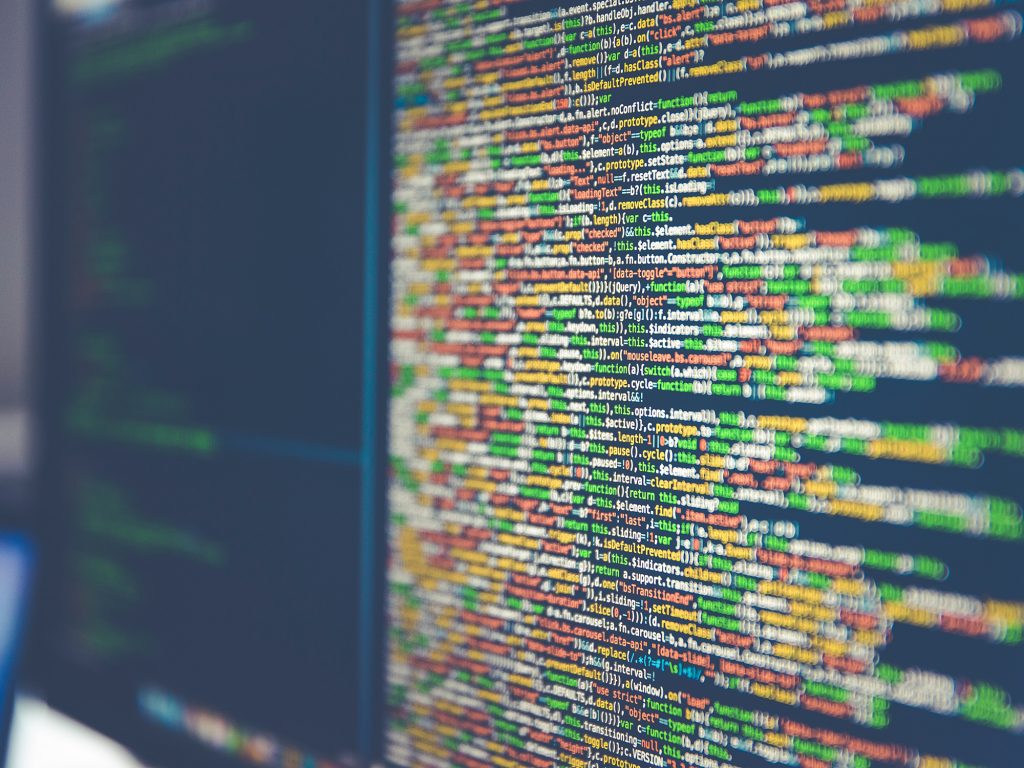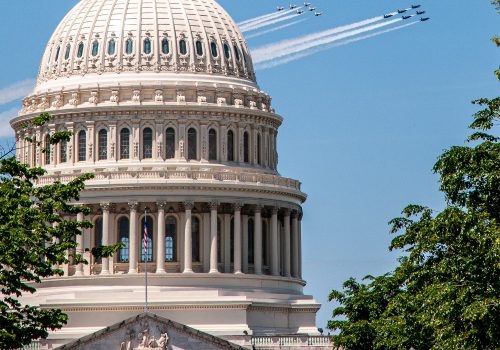II. The convergence of national security and economics
This chapter is part of a larger report—Economic might, national security, and the future of American statecraft. Read the chapters here or download the PDF.
National security and economics have long been connected, and, since its earliest days, the United States has leveraged that reality to advance its national objectives.1Robert Blackwill and Jennifer Harris review the foundations of economic statecraft and America’s long history of employing economic power in, Robert D. Blackwill and Jennifer M. Harris, War by Other Means: Geoeconomics and Statecraft (Cambridge, MA: Harvard University Press, 2016). However, since World War II, these two spheres have grown ever more intertwined. In many respects, that convergence bolstered American primacy, particularly as a result of America’s influence over the global economy and its leadership of international institutions and in innovation.
Economic interdependence between states is unbalanced, giving some states an asymmetric, or disproportionate, ability to influence their economic partners. Over time, globalization has also led to the development of asymmetric networks, which have given certain countries, particularly the United States, outsized advantage.2Henry Farrell and Abraham L. Newman, “Weaponized Interdependence: How Global Economic Networks Shape State Coercion,” International Security 44, no. 1 (Summer 2019): 42–79, https://doi.org/10.1162/isec_a_00351. Today, money and information flow through central locations in the global economy, and the United States has long had preponderant influence over those choke points. With jurisdiction over the “hubs” of financial and information flows, such as The Society for Worldwide Interbank Financial Telecommunication (SWIFT) and the dollar clearance system, and the institutions built to enforce that jurisdiction, the United States has often been ahead of the curve in its use of economic tools for national security purposes.3Former Bush administration official Juan Zarate has documented some of the innovative ways he and his colleagues used financial tools to punish and coerce rogue actors, especially through Section 311 sanctions. See, Juan C. Zarate, Treasury’s War: The Unleashing of a New Era of Financial Warfare (New York: PublicAffairs 2013). Moreover, U.S. leadership allowed America to set the standards for many existing technologies and shape the formation of international institutions, further extending its influence.
However, the accelerated convergence of national security and economic affairs now threatens to undermine America’s traditional power, as can be seen in three interdependent trends: 1) increasing economic interdependence and the shifting geography of the global economy; 2) the international development of transformational, dual-use technologies; and 3) the increasing ubiquity and importance of cyberspace. It is important to understand these trends before determining what steps the United States should take to address them.
Economic interdependence
After World War II, global trade began to grow rapidly, and that growth has accelerated over the past 50 years. Trade, as a share of global GDP, has roughly doubled relative to the 1970s.4Greg Jensen, Atul Narayan, Daniel Crowley, and Same Green, “Peak Profit Margins? A Global Perspective,” Bridgewater Associates, LP, March 27, 2019, https://www.bridgewater.com/research-library/daily-observations/peak-profit-margins-a-global-perspective/. Today, nearly half of the goods manufactured in the United States are exported, and supply chains have grown more complex.5The United States leads in high-end semiconductor design, but China produces 70 percent of the rare earth metals and South Korea leads on displays and other crucial inputs. Jason Rotenberg and Jeff Amato, “Peak Globalization?” Bridgewater Associates, LP, November 11, 2016; and Magdalena Petrova, “We Traced What It Takes to Make an iPhone,” CNBC, Dec. 14, 2018, https://www.cnbc.com/2018/12/13/inside-apple-iphone-where-parts-and-materials-come-from.html. Although economic interdependence has plateaued in recent years, major economies are significantly more interdependent today than they were at the beginning of the century.6Signs of reduced interdependence include the leveling off of growth for exports and corporate foreign sales, according to research done by Bridgewater Associates, LP. See, e.g., “Peak Profit Margins? A Global Perspective.” In some instances, economic interdependence has exacted significant costs to both national security and American communities, as recently evidenced by America’s dependence on China-based supply chains during the COVID-19 crisis.
China is pushing to join the United States and Europe as a primary monetary system, and Asia — in particular China — has become the key driver of global growth.
For many decades, America’s central role in the global economy allowed it to set the standards for many existing technologies, shape the formation of international institutions, and develop leverage over primary choke points in the global economy. But that balance of the global economy is arguably shifting toward Asia. China is competing for greater leverage and jurisdiction and is encouraging the reintegration of Asia writ large.7Some of those efforts, notably One Belt One Road, appear to be running out of steam, but not all. See, Derek Scissors, “The Belt and Road Is Overhyped, Commercially,” Statement Before the Senate Finance Committee Subcommittee on International Trade, Customs, and Global Competitiveness, June 12, 2019, https://www.finance.senate.gov/imo/media/doc/Derek%20Scissors%20-%20BRI%20Testimony.pdf. Some even see a multipolar world emerging, which would severely degrade America’s ability to influence a “China-centric Asia” through economic or political means.8“Globalisation Is Dead and We Need to Invent a New World Order,” The Economist, June 28, 2019, https://www.economist.com/open-future/2019/06/28/globalisation-is-dead-and-we-need-to-invent-a-new-world-order.
Although previous predictions of American decline have proven to be overly pessimistic, a tri-polar economic environment may be emerging. China is pushing to join the United States and Europe as a primary monetary system,9Although use of the RMB remains low in comparison to the U.S. dollar or the Euro, it is the currency for the primary market in the engine of economic growth — Asia. Moreover, China’s monetary policy operates independently from the U.S. Federal Reserve’s. See, “2020 Strategic Report: Our Economic Outlook,” Bridgewater Associates, 2020, https://www.bridgewater.com/outlook2020/Bridgewater-Associates-2020-Strategic-Report.pdf. and Asia — in particular China — has become the key driver of global growth.10“2020 Strategic Report.” Significant divisions remain within Asia, but this new environment, left unchecked, threatens to diminish America’s historical advantages, including its ability to influence the behavior of other states.
Transformational technologies
Longstanding U.S. leadership in technological development and innovation is also being contested — especially in sectors with significant security implications, such as 5G — though the United States continues to lead in machine learning and quantum sciences. These and other transformational technologies offer significant economic and military potential. The race to develop 5G, for example, could have a profound effect not only on economic prosperity,11By some estimates, 5G could add another $500 billion to America’s GDP and generate another $12.3 trillion in global sales. Michael Kratsios, “America Will Win the Global Race to 5G,” Office of Science and Technology Policy, Oct. 25, 2018, https://www.whitehouse.gov/articles/america-will-win-global-race-5g/; Jill C. Gallagher and Michael E. DeVine, “Fifth Generation (5G) Telecommunications Technologies: Issues for Congress,” Congressional Research Service, Jan. 30, 2019, https://fas.org/sgp/crs/misc/R45485.pdf; and Karen Campbell et al., “The 5G Economy: How 5G Technology Will Contribute to the Global Economy,” IHS Markit, January 2017, https://cdn.ihs.com/www/pdf/IHS-Technology-5G-Economic-Impact-Study.pdf. but also on national security.125G, for example, is expected to facilitate new military and intelligence applications, and vulnerabilities in 5G equipment could be used to conduct cyber attacks and espionage or to engage in military or industrial sabotage. John R. Hoehn and Kelley M. Sayler, “National Security Implications of Fifth Generation (5G) Mobile Technologies,” Congressional Research Service, June 12, 2019, updated March 25, 2020, https://fas.org/sgp/crs/natsec/IF11251.pdf. Moreover, 5G appears to be a winner-take-all sector where control of the infrastructure equates to control of data — data that will drive the emerging global economy and prove essential to effective national defense.13If one company is contracted to provide the bulk of the network architecture, it could quickly knock its competitors out of the market. Jenalea Howell, “Press Release: Number of Connected IoT Will Surge to 125 billion by 2030, IHS Markit Says,” InformaTech, Oct. 24, 2017, https://technology.ihs.com/596542/number-of-connected-iot-devices-will-surge-to-125-billion-by-2030-ihs-markit-says; Zak Doffman, “Network Effects: In 2019 IoT and 5G Will Push AI to the Very Edge,” Forbes, Dec. 28, 2018, https://www.forbes.com/sites/zakdoffman/2018/12/28/network-effects-in-2019-iot-and-5g-will-push-ai-to-the-very-edge/#5c619a396bbe; Peter Harrell, “5G: National Security Concerns, Intellectual Property Issues, and the Impact on Competition and Innovation,” Testimony Before the United States Senate Committee on the Judiciary, May 14, 2019, https://www.judiciary.senate.gov/imo/media/doc/Harrell%20Testimony.pdf; and Hoehn and Sayler, “National Security Implications of Fifth Generation (5g) Mobile Technologies.” It is clear that if a bad actor can access any portion of the communications networks, the data that flows through that network will be compromised.14See, Tom Cotton and John Cornyn, “Keep the Chinese Government Away from 5G technology,” Washington Post, April 1, 2019, https://www.washingtonpost.com/opinions/keep-the-chinese-government-away-from-5g-technology/2019/04/01/ba7a30ac-54b3-11e9-9136-f8e636f1f6df_story.html. Unfortunately, the Chinese firm Huawei is outpacing its competitors in developing 5G, in part because it has received massive state subsidies and can offer favorable financing terms to prospective clients, which threatens the long-term security of U.S. data, and that of its allies and partners.15Huawei has received, by some measures, as much as $75 billion in subsidies, tax breaks, and other forms of state support. Chuin-Wei Yap, “State Support Helped Fuel Huawei’s Global Rise,” Wall Street Journal, Dec. 25, 2019, https://www.wsj.com/articles/state-support-helped-fuel-huaweis-global-rise-11577280736.

Photo by Markus Spiske on Unsplash
In other technological sectors where the United States remains the leader, such as artificial intelligence (AI)-related technologies and quantum sciences, that leadership is not guaranteed. These technologies will likely have significant economic and national security implications,16Although estimates vary, one projection suggests that the total economic activity attributable to AI will total more than $13 trillion by 2030, and AI will likely radically change how businesses operate. Moreover, machine learning will likely offer new military capabilities, including advanced autonomous systems and more efficient intelligence gathering, and is expected to revolutionize cyber security, threat intelligence, and other applications relying on faster data-processing speeds. Jacques Bughin et al., “Notes from the AI Frontier: Modeling the Impact of AI on the World Economy,” McKinsey & Company, September 2018, https://www.mckinsey.com/featured-insights/artificial-intelligence/notes-from-the-ai-frontier-modeling-the-impact-of-ai-on-the-world-economy. See also, Mark Esper, “Remarks by Secretary Esper at National Security Commission on Artificial Intelligence Public Conference,” Department of Defense, Nov. 5, 2019, https://www.defense.gov/Newsroom/Transcripts/Transcript/Article/2011960/remarks-by-secretary-esper-at-national-security-commission-on-artificial-intell/. Although quantum computing is expected to have a slower build than 5G and AI, once matured, the value in this area could spike to $50 billion or more by 2030. Massimo Russo, Anant Thaker, and Suhare Adam, “The Coming Quantum Leap in Computing,” Boston Consulting Group, May 16, 2018, https://www.bcg.com/en-us/publications/2018/coming-quantum-leap-computing.aspx. and whoever leads in their development will set their standards and gain the immense competitive advantages they offer.17Summary of the Department of Defense Artificial Intelligence Strategy, Department of Defense, 2018, https://media.defense.gov/2019/Feb/12/2002088963/-1/-1/1/SUMMARY-OF-DOD-AI-STRATEGY.PDF. America’s innovative edge cannot be taken for granted, and preserving it will require significant national commitment.18In the words of Attorney General William Barr, “For the first time in history, the United States is not leading the next technology era.” William Barr, “Keynote Address at the Department of Justice’s China Initiative Conference,” Department of Justice, Feb. 6, 2020, https://www.justice.gov/opa/speech/attorney-general-william-p-barr-delivers-keynote-address-department-justices-china.
Cyberspace
With more than 4 billion Internet users, cyberspace has been a driving force behind global economic growth for three decades. It also increasingly ties into the physical world.19Including to infrastructure, public health systems, and other elements of the “Internet of Things.” See, for example,Kate O’Flaherty, “U.S. Government Makes Surprise Move to Secure Power Grid for Cyberattacks,” Forbes, July 3, 2019, https://www.forbes.com/sites/kateoflahertyuk/2019/07/03/u-s-government-makes-surprise-move-to-secure-power-grid-from-cyber-attacks/#64b90e863191; and “ICS Medical Advisory (ICSMA-19-080-01),” Department of Homeland Security, March 21, 2019, https://www.us-cert.gov/ics/advisories/ICSMA-19-080-01. This medical advisory warned that hundreds of thousands of implanted defibrillators, programmers, and heart monitors could be subject to cyber attacks. At the same time, as the Cyberspace Solarium Commission warned, “a broad array of threat actors are exploiting global connectivity to achieve their objectives.”20Report of the Cyberspace Solarium Commission, Cyberspace Solarium Commission, March 2020, 8, https://www.solarium.gov/. The commission documented recent, illicit operations conducted by Russia, China, Iran, North Korea, and non-state actors and echoed the Trump administration’s 2018 National Cyber Strategy in warning about the numerous vulnerabilities inherent to ubiquitous connectivity.21The cyber operations highlighted in the report include well-known cases, such as North Korea’s 2014 cyber attack on Sony Pictures Entertainment, China’s 2017 breach of Equifax, and the NotPetya attack on Ukraine in the same year, which spread globally and cost companies as much as $10 billion. Report of the Cyberspace Solarium Commission, 8–14. National Cyber Strategy of the United States, The White House, September 2018, https://www.whitehouse.gov/wp-content/uploads/2018/09/National-Cyber-Strategy.pdf.
The United States, Europe, and China have developed three competing visions of Internet and data governance, but no international consensus has emerged, further complicating the global landscape
Moreover, multinational technology companies have been sources of incredible innovation and economic development for the United States and the world, but they also short-circuit the traditional economic network and act almost as international governing bodies. They increasingly operate as choke points of information flows themselves and could soon create new networks of financial transactions.22Facebook’s development of an Internet-native currency, Libra, which is discussed later in the paper. For more on information networks, see, Niall Ferguson, The Square and the Tower: Networks and Power, from the Freemasons to Facebook (New York: Penguin Books, 2017). The United States, Europe, and China have developed three competing visions of Internet and data governance, but no international consensus has emerged, further complicating the global landscape.23See, for example, China’s “New IP” proposal, presented to the International Telecommunications Union. Madhumita Murgia and Anna Gross, “Inside China’s Controversial Mission to Reinvent the Internet,” Financial Times, March 27, 2020, https://www.ft.com/content/ba94c2bc-6e27-11ea-9bca-bf503995cd6f.



